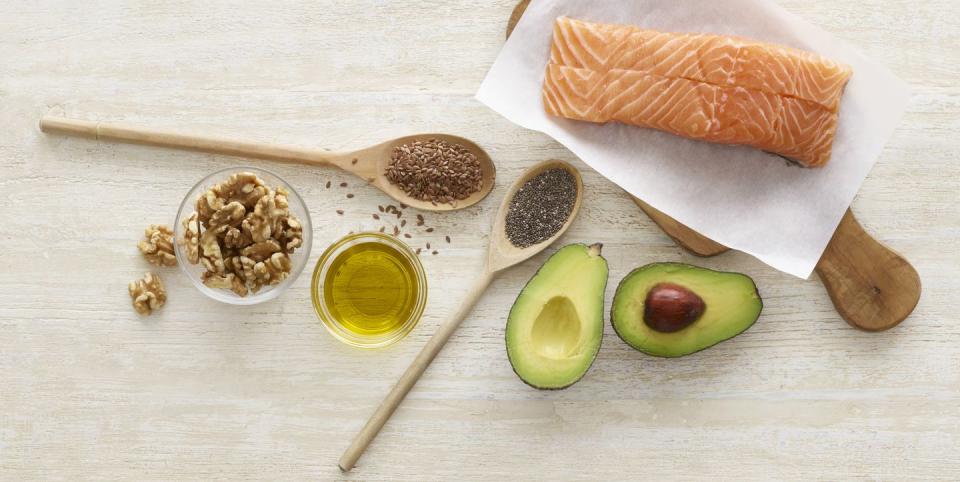Nutritionists Kim Pearson and Renee McGregor explain what omega-3 fats are and what the benefits are for runners

Essential fatty acids and, principally, omega-3 fatty acids have been linked to numerous health benefits, including supporting the cardiovascular system, reducing inflammation and more. Recently, research has shown strong positive associations with the prevention of cognitive decline. When it comes to sports nutrition, there is lots of evidence that the inclusion of omega-3 fatty acids can support performance, encourage recovery and help manage inflammation.
What are omega-3 fatty acids?
‘Omega-3 fatty acids are a group of polyunsaturated fats that are essential for human health,’ says nutritionist Kim Pearson.
‘Omega-3 fatty acids have a third carbon double bond within their biochemical structure, thus known as omega-3,’ adds sports dietician Renee McGregor. ‘The three main and most researched are EPA (eicosapentaenoic acid), DHA (docosahexaenoic acid) and
ALA (alpha-linolenic acid). If you consume fish oil supplements, you’ll see that EPA and DHA are the main components and they are the fatty acids most often associated with health and performance benefits.’
The best-utilised forms of omega-3 come from cold-water oily fish such as salmon, herring and sardines. ‘This is why oily fish such as salmon, mackerel, sardines and kippers are encouraged as part of a balanced diet as they’re great sources of EPA and DHA,’ says McGregor.
You can also find omega-3 (ALA) in plant sources, including chia seeds, linseeds, walnuts and flax seeds. ‘It has been shown that ALA can be made into EPA and DHA in the body, but the rate of conversion is low,’ she says.
How much omega-3 should we eat?
For many years, the advice has been to aim to consume one to two portions of oily fish a week. ‘Many nutrients have specific recommended daily allowances, but there are none for omega-3 fatty acids,’ says McGregor. ‘In fact, there are a number of mixed messages. The Canadian Association of Nutrition and Dietetics recommends 0.5g of EPA and DHA combined daily, while the European Food Safety Authority says 0.25g. In contrast, the American Heart Association recommends that those with coronary heart disease should include 1g of EPA and DHA per day, while those with elevated triglycerides should aim for
2g to 4g.’
When it comes to runners, it’s worth considering training load, inflammatory response to exercise and energy metabolism, she says. ‘This would suggest that requirements will be higher. If we extrapolate data from other nutrient studies, it has often been shown that in order to benefit from ergogenic properties, doses need to be higher than usual.’
Why are they good for runners?
Omega-3 fatty acids are particularly beneficial for runners because of their anti-inflammatory benefits, says Pearson, helping to reduce delayed onset muscle soreness (DOMS) and increasing blood flow to the muscles during our runs.
‘Omega-3 fatty acids have also been shown to encourage bronchodilation [the widening of bronchi in the lungs],’ adds McGregor. ‘Thus supporting lung function, essential for most runners; as well as strong links with improved muscular recovery and cognitive function.’
Reasons why we don’t get enough Omega 3
Many of us don’t consume enough omega-3s. Why? ‘One theory is our very distant ancestors consumed far more omega-3s than we do today because of the cooler conditions; animals needed to protect themselves more from the climate, so fish retained higher levels of fat, providing greater amounts when our ancestors ate them,’ explains Pearson.
‘Today, the earth is warmer and fish don’t tend to hold on to their body fat in such quantities. What’s more, much of the fish in our supermarkets today is not wild but farmed. The quality and quantity of fats are affected by what the fish has eaten. As a result, whether a farmed fish has been fed good, nutritious food or cheaper alternatives will affect the quality.’
Of course, non-fish sources of omega-3 do exist, but they don’t provide the active forms of EPA and DHA. ‘This means that our bodies are left with the job of converting omega-3 to its active form, and how effectively this is carried out varies from one person to the next,’ she says.
How to optimise your levels
As with most nutrients, a food-first approach is always the best policy, says McGregor, who suggests including oily fish into your diet at least twice a week – such as fresh salmon, sardines and bluefin tuna.
‘Tinned versions of these oily fish still have benefits with slightly lower doses, with the exception of tinned tuna, which loses a lot of its EPA and DHA when it’s processed,’ says McGregor.
Is it worth supplementing with omega-3?
The short answer is yes. ‘For those runners who do not consume oily fish, a supplement can be useful, with plant-based runners choosing an algae-based option,’ says McGregor.
‘Despite regularly eating omega-3, I take a fish oil supplement to ensure I get enough,’ adds Pearson. ‘I recommend avoiding cod liver oil in any form. After all, the liver is the organ of filtration and detoxification, while fish oils are made from the flesh of fish.’
The recommended dosage with regards to supplementation will vary based on activity level and type of sport, but for most runners, aiming for 0.5g to 2g of EPA and DHA combined each day seems to be appropriate.
‘Choose a high-quality omega-3 supplement. Look for a five-star rating from International Fish Oil Standards (IFOS). This is one of the best ways to know that your fish oil contains a high level of fats and a low level of contaminants,’ says Pearson.
Kim Pearson is a nutritionist with over 10 years’ experience and Renee McGregor is a leading sports dietitian with over 20 years’ experience.
You Might Also Like

 Yahoo Finance
Yahoo Finance 